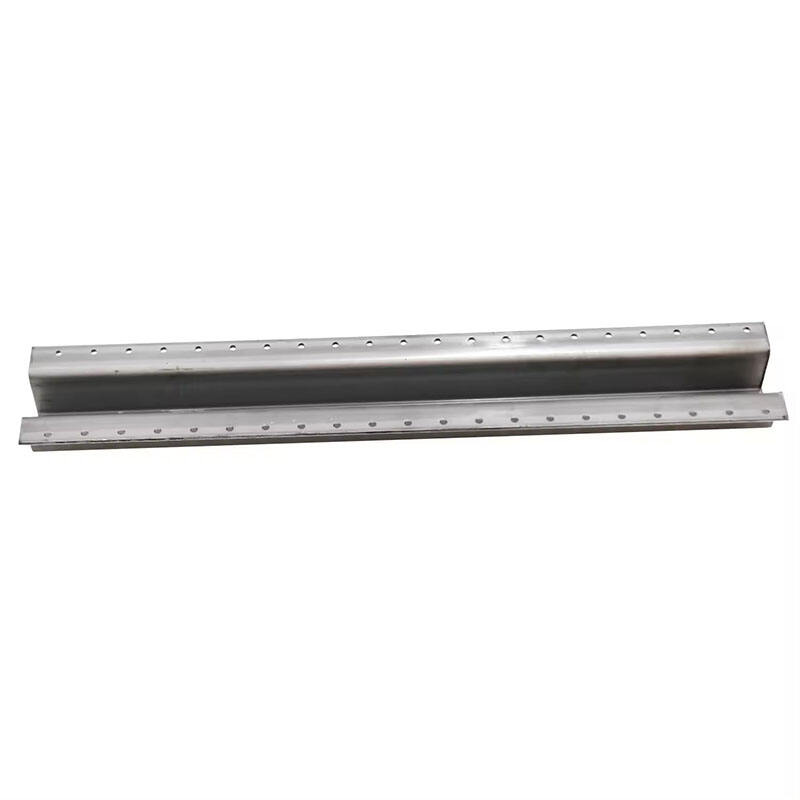Fundamentals of Zinc-Based Galvanization
Galvanization is a crucial process in enhancing the corrosion resistance of cold-formed steel. It involves applying a protective zinc coating to steel to prevent rust and extend its durability. The two primary methods of galvanization are hot-dip galvanizing and electro-galvanization. In hot-dip galvanizing, the steel is submerged in molten zinc, forming a thick, protective layer through a metallurgical bond. Electro-galvanization, on the other hand, involves using an electric current to apply a zinc layer, offering a thinner and more uniform coating. Studies show galvanized coatings can offer up to 100 years of protection against corrosion under optimal conditions, making it a superior choice compared to unprotected steel.
Protective Mechanisms of Painted Coatings
Painted coatings are another method for protecting steel, offering a barrier against moisture and corrosive elements. Common types include epoxy, polyurethane, and acrylic paints, each providing varying degrees of protection and aesthetic appeal. These coatings form a physical barrier on the steel surface that helps prevent moisture intrusion, a primary cause of rust. According to research, painted finishes can last 20 to 25 years, depending on environmental conditions and maintenance practices. They provide flexibility in color and finish, allowing for design customization in addition to protection.
Key Structural Differences in Application
When comparing the application methods of galvanized and painted finishes, several structural differences emerge. Galvanization, especially hot-dip, requires less labor and time since the process can coat steel both internally and externally uniformly. Painted coatings, while more adaptable in terms of color, require meticulous surface preparation to ensure adhesion, often making the process more labor-intensive. Case studies in construction indicate that galvanized steel maintains structural integrity better over time, especially in environments prone to moisture and wear. This underlines the importance of selecting the right finish based on the specific structural and environmental demands of the application.
Sacrificial Protection in Galvanized Steel
Sacrificial protection is a cornerstone of how galvanized steel defends against corrosion. This method employs the principle of a sacrificial anode, where zinc coating corrodes in place of the steel, effectively preserving the integrity of the structure beneath. This concept, widely reliant on zinc-based galvanization, ensures galvanized steel's longevity by allowing the zinc to wear away instead of the steel. According to research, galvanized coatings can boost corrosion resistance by up to 100 years in optimal environments, a testament to its durability compared to untreated steel. Factors such as environmental conditions and the thickness of the galvanization layer significantly influence the endurance of the sacrificial layer.
Barrier Defense of Painted Finishes
Painted finishes provide a critical barrier defense against corrosive elements, especially in environments where moisture and air pollutants are prevalent. Typically, these coatings consist of durable materials like epoxy or polyurethane, which form a protective layer over the steel. This layer works to shield the steel from direct exposure to corrosive factors such as water and environmental chemicals. In certain conditions, painted finishes can outperform galvanized coatings; for instance, in indoor settings or lower-exposure environments where mechanical damage risks are minimized. Studies have shown that, in controlled environments, quality painted coatings can last 20 to 25 years, maintaining robust corrosion resistance.
Performance in Coastal/Harsh Environments
When comparing the performance of galvanized and painted finishes in coastal and harsh environments, various factors such as salinity and humidity play crucial roles. Galvanized steel is exceptionally effective in such settings due to its sacrificial anode mechanism, which actively resists corrosion from salty air and high humidity. Additionally, research has revealed that galvanized steel can endure these conditions far better than painted surfaces, which may peel under intense heat or humidity. Statistical comparisons from environmental studies demonstrate galvanized coatings' superiority in retaining their protective properties over painted finishes. For such challenging conditions, recommendations often favor galvanized finishes due to their proven resilience and long-term effectiveness.
Lifespan Expectations for Each Finish Type
When considering the lifespan of galvanized and painted finishes, it's crucial to understand the significant differences between these two methods. Galvanized finishes, such as those achieved through hot-dip galvanizing, can provide protection for steel structures for 50 years or more in certain environments. On the other hand, painted finishes typically last between 15 to 25 years, depending primarily on environmental conditions and maintenance. The longevity of galvanized coatings is attributed to their ability to form a metallurgical bond with the metal, enhancing durability and corrosion resistance. Factors like UV exposure, humidity, and mechanical wear can substantially affect the lifespan of both finishes. Real-world examples, such as the longevity of bridges and industrial machinery, have demonstrated that galvanized coatings outperform painted ones in terms of durability, reducing the need for frequent recoating. Thus, for industries seeking long-lasting protection, galvanizing often emerges as the preferred choice.
Repair Considerations for Damaged Coatings
Repairing damaged coatings requires different approaches for galvanized and painted finishes. Galvanized surfaces, benefiting from cathodic protection, are more resilient and thus easier to repair by applying a cold galvanizing compound or zinc-rich paint to restore the sacrificial layer. This process is generally cost-effective and ensures prolonged corrosion resistance. In contrast, repairing painted finishes often demands more intensive labor and materials, as damage usually necessitates complete removal and reapplication of the coating. The costs associated with repairing painted finishes can be burdensome, and the outcomes may not always match the original protection level. To extend the longevity of painted surfaces, regular inspections and maintenance, including touch-ups on susceptible areas, are advisable. By following these best practices, both galvanizing and painting can offer reliable protection, albeit with differing maintenance complexities.
Environmental Stability Across Temperature Extremes
The performance of galvanized and painted finishes under temperature extremes is a critical factor in finish selection. Galvanized finishes excel in withstanding temperature fluctuations, maintaining structural integrity and resisting corrosion even at high temperatures. Studies indicate that galvanizing can endure temperatures up to 200°C (390°F) without significant degradation. Painted finishes, however, are more susceptible to extreme temperatures, where high heat can cause cracking or peeling, compromising the underlying metal. Research shows that galvanizing is more effective in environments experiencing temperature variations, such as deserts or coastal regions. For regions with severe climate conditions, choosing a galvanized finish ensures consistency in protection over time, minimizing maintenance issues related to environmental stressors. Hence, in selecting a finish, it's essential to consider the local climate and its potential impact on long-term performance.
Lifecycle Cost Analysis for Solar Power Systems
Understanding the lifecycle costs associated with different finishes in solar power systems is crucial for financial planning and investment returns. Generally, hot dip galvanizing is known for its long-lasting durability, which translates to lower maintenance costs over time. Comparative analysis suggests that while initial investments in galvanizing might be higher, the total cost of ownership becomes more economical as maintenance needs diminish. A recent study outlined that the total lifecycle cost of galvanized finishes can be up to 70% less expensive than painted coatings over a 25-year period, ensuring prolonged economic benefits for solar installations. These cost savings have been evident in multiple case studies of solar panel projects, where a substantial reduction in maintenance expenses allowed for a more stable financial bottom line.
Finish Selection for Solar Panel Mounting Structures
Proper finish selection for solar panel mounting structures is pivotal, as it greatly influences the system’s longevity and efficiency. Here, corrosion resistance plays a critical role in ensuring long-term performance. Galvanized finishes offer superior protection against environmental elements compared to painted options, which can chip away or degrade in harsh conditions. Selecting a finish with strong corrosion resistance helps minimize long-term maintenance costs and increases the lifespan of the mounting structures. Successful solar projects, such as those in marine or desert environments, have demonstrated that galvanized steel frameworks provide consistent performance, safeguarding the panels against extreme weather conditions.
Optimizing Solar Installation Cost-Effectiveness
To maximize the cost-effectiveness of solar installations, evaluating finish options is imperative. Implementing strategic choices that enhance the durability and efficiency of the installation can significantly decrease total costs. Best practices include choosing finishes that require minimal maintenance and have a proven record of withstanding environmental stresses without compromising performance. According to industry data, galvanizing helps achieve these goals and is often preferred for its long-lasting characteristics, even under intense solar exposure. Thus, considering the impact of finish selection on solar installation costs and overall performance is a practical approach to ensuring economic and operational sustainability.
Table of Contents
- Fundamentals of Zinc-Based Galvanization
- Protective Mechanisms of Painted Coatings
- Key Structural Differences in Application
- Sacrificial Protection in Galvanized Steel
- Barrier Defense of Painted Finishes
- Performance in Coastal/Harsh Environments
- Lifespan Expectations for Each Finish Type
- Repair Considerations for Damaged Coatings
- Environmental Stability Across Temperature Extremes
- Lifecycle Cost Analysis for Solar Power Systems
- Finish Selection for Solar Panel Mounting Structures
- Optimizing Solar Installation Cost-Effectiveness






